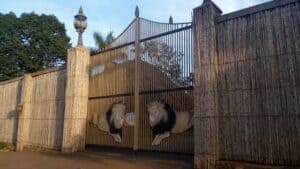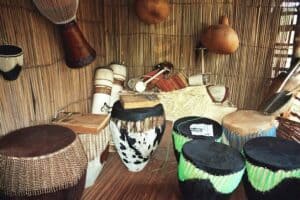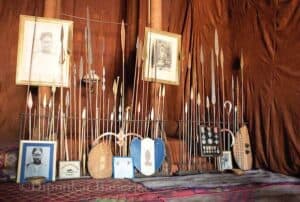![]() Namaganda Lyndah
Namaganda Lyndah
Sunday is quiet around the streets of Kampala as it is the one day when most businesses are closed and congregations gather in the vast number of churches around the city. It is a good time to take a walk somewhere. I chose Kasubi tombs, just on Kasubi Hill.
 Originally Kasubi hill was called Nabulagala. When Ssekabaka Mwanga I established his palace on the hill in 1882, he changed its name to Kasubi, a village in Kyagwe where he grew up. Kasubi hill is a cultural site on where the four Kabakas (Kings of Buganda Kingdom) and other members of the royal family a
Originally Kasubi hill was called Nabulagala. When Ssekabaka Mwanga I established his palace on the hill in 1882, he changed its name to Kasubi, a village in Kyagwe where he grew up. Kasubi hill is a cultural site on where the four Kabakas (Kings of Buganda Kingdom) and other members of the royal family a
re buried.
The Kasubi tombs on Kasubi hill is an important spiritual and political site for the Baganda people, as well as an important example of traditional architecture. Kasubi tombs was described as one of the most remarkable buildings using purely vegetal materials in the entire region of sub-Saharan Africa hence becoming a UNESCO World Heritage site in December 2001.
On the top of Kasubi hill inside is the main tomb building, locally called “Muzibu-Azaala-Mpanga” which is a masterpiece of this ensemble. Muzibu-Azaala-Mpanga has been in existence since the 13th century. The latest building was the former palace of the Kabakas of Baganda built in 1882 and later converted into the royal burial ground in 1884 after Kabaka Mwanga I moving the palace to Mengo hill. Four royal tombs now lie within the Muzibu-Azaala-Mpanga.
Setting off for my walk around from Nakulabye, It took me only 15minutes to reach Kasubi hill by foot. On the hill, there’s an entrance gate locally referred to as “Bujjabukula”. At this gate, it’s where guards control access to the main building “Muzibu-Azaala-Mpanga”. From this gate, I paid a small entrance fee of 10,000 Ugx that’s roughly around 3$. I was permitted to the main courtyard where houses were built for the widows of the King.
From the courtyard, I was able to clearly see Muzibu-Azaala-Mpanga. It is large and circular in shape and this gives it unexceptional beauty.
Upon entering this place, one moves into a structure with a thick thatched roof, which they call Sacred Forest. It is in this Forest that the 4 Royal graves are present. I must confess I was already nervous and scared to walk through it, but got saved by the tour guide when he said it’s only widows of the Kabakas, the royal family, the Naalinya, and Katikkiro who are allowed there.
Furthermore, I was told Kasubi tombs is divided into three parts. The first being the tombs, second is the huge agricultural area on the eastern side of the hills, and finally the secondary graveyard and living area behind the original site.
I was walked to the secondary graveyard and the living area behind the original site. From this place, I was able to see drums, spears, shields, barkcloth, medals and photographs of the Kabakas buried in the Muzibu-Azaala-Mpanga.
 The drums in Buganda were traditionally used for communication. In case there was any information to put across it was drummed with lyrical words of “Gwanga Mujje Gwanga Mujje” and people would gather or listen to what was being communicated. The drums are also used for entertainment…Kiganda dance and songs are more catchy when accompanied by musical drummings.
The drums in Buganda were traditionally used for communication. In case there was any information to put across it was drummed with lyrical words of “Gwanga Mujje Gwanga Mujje” and people would gather or listen to what was being communicated. The drums are also used for entertainment…Kiganda dance and songs are more catchy when accompanied by musical drummings.
 The spears and shields were used by the Baganda for protection to fight against enemies and also used for hunting back them.
The spears and shields were used by the Baganda for protection to fight against enemies and also used for hunting back them.
The barkcloth in Buganda has historical, traditional and spiritual values. It is a major link to the spiritual world. Traditionalists wear it when communicating with the Kabaka. Barkcloth is a must-have during ancestral worship because, as the Baganda believe, it appeases the gods to pour out their blessings.
From there we headed to the third part which is the agriculture side. Here I was transfixed by nature and farming. I saw a multitude of banana plants locally called “matooke”. There were other food crops such as cassava and sweet potatoes in the garden but not as many as banana plants. This clearly proves matooke as the staple food for Baganda people.
Among other things, I saw in the garden are the birds, nests and chicks, in front of me. It was amazing to see the pretty busy weaver birds in numbers in such small and big shrubby trees. There was some squabbling, particularly among the juveniles and some crafty theft of nesting materials when a neighbour was absent, but mostly they seemed to coexist well.
When not on their nest, they were flying to trees and grass, to collect nesting material.
I couldn’t help but be enchanted by the fluffy chicks waiting, not always patiently, for their next meal.
From the Kasubi hilltop of Kasubi, I had a clear view of Namirembe Cathedral on Mengo hill, Makerere hill and Old Kampala hill.
Would you like to check out Kasubi tombs? It’s only 5 km from Kampala City centre and takes 15 minutes to reach there by taxi. Visit the Kasubi Royal Tombs.
 Namaganda Lyndah is a Writer/Author at Ada Uganda
Namaganda Lyndah is a Writer/Author at Ada Uganda

Almost all of what you claim happens to be supprisingly accurate and that makes me ponder why I hadn’t looked at this in this light previously. This article truly did switch the light on for me as far as this specific subject goes. Nevertheless there is one issue I am not necessarily too comfy with so whilst I make an effort to reconcile that with the actual main theme of your position, permit me observe just what the rest of your readers have to point out.Well done.
You actually make it seem really easy together with your presentation but I find this topic to be really one thing which I believe I’d by no means understand. It kind of feels too complex and extremely extensive for me. I’m looking forward in your next post, I抣l try to get the cling of it!
Heya i am for the first time here. I found this board and I find It truly useful & it helped me out a lot. I hope to give something back and aid others like you aided me.
Hey very nice blog!! Man .. Beautiful .. Amazing .. I’ll bookmark your site and take the feeds also厈I am happy to find numerous useful information here in the post, we need work out more strategies in this regard, thanks for sharing. . . . . .